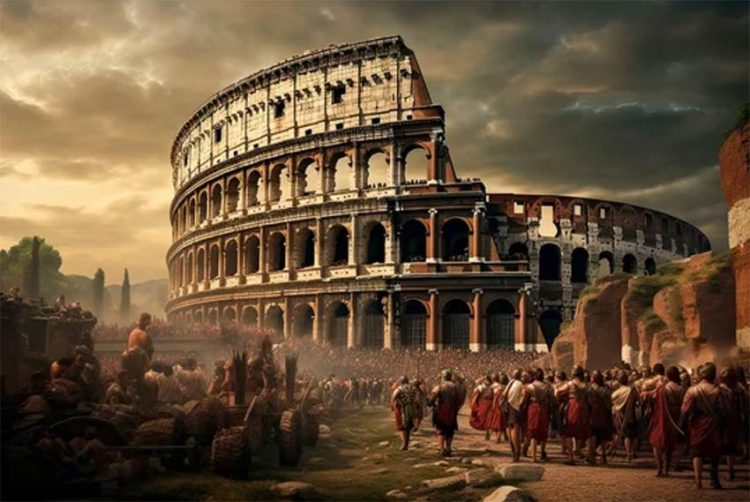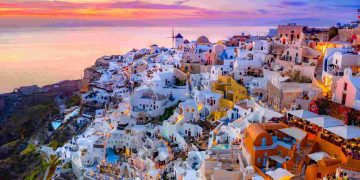Introduction: The Colosseum as a Cultural Epicenter
The Colosseum, also known as the Flavian Amphitheater, stands as one of the most iconic and influential landmarks in human history. While it is known primarily for its architectural grandeur and as a venue for gladiatorial combat, the Colosseum was also a cultural heart of Ancient Rome. It was not just a place for entertainment but a stage where customs, rituals, and public life converged. From the gladiators who fought to the emperors who orchestrated these spectacles, the Colosseum was a site where political, religious, and social customs were deeply intertwined.
In this article, we will explore the cultural customs that defined the Colosseum, from the gladiatorial games and political spectacles to the religious rituals and the societal roles they played. We will also delve into how the Colosseum represented Roman values, power dynamics, and public interaction, and how these customs have shaped the monument’s legacy today.
1. What Was the Role of the Colosseum in Roman Society?
The Colosseum as a Symbol of Roman Power
In Ancient Rome, the Colosseum was more than just a venue for entertainment; it was a powerful symbol of Roman authority and the emperor’s ability to manipulate public opinion. The construction of such a massive structure, capable of holding 50,000 to 80,000 spectators, was an unparalleled feat that showcased Rome’s wealth, engineering prowess, and dominance. But the cultural customs surrounding the Colosseum also reflected the way the Roman Empire maintained control over its people.
- Bread and Circuses (Panem et Circenses): The phrase “bread and circuses” was coined by the Roman poet Juvenal to describe the political strategy of providing free food and public spectacles to distract the populace from social issues. The Colosseum’s games played a central role in this strategy, offering the people a form of entertainment that also served as a tool of pacification.
- Imperial Power Display: Emperors used the Colosseum to demonstrate their generosity and power. Gladiatorial games, animal hunts, and mock naval battles were often funded by the emperor to win the favor of the masses, especially during times of political instability or when an emperor sought to solidify their reign.
Gladiatorial Combat: The Cultural Centerpiece
The gladiatorial games were the hallmark of Colosseum spectacles and remained the most celebrated events held within its walls. But these games were not just about bloodshed and violence—they were deeply embedded in the social fabric and religious customs of Ancient Rome.
Origins of Gladiatorial Combat
The origins of gladiatorial combat date back to Etruscan funeral rituals, where slaves fought in armed combat to honor the deceased. However, it wasn’t until the Roman Republic (509–27 BC) that gladiatorial games became a formalized institution. These combats grew into a spectacle for public entertainment, especially under the reign of the emperors, who used them to gain political favor.
The Role of Gladiators in Roman Culture
Gladiators were typically slaves, prisoners of war, or criminals. However, some volunteers, known as auctorati, chose to fight for the prize money and fame. These men (and sometimes women, though rarer) were trained in special schools called ludi (gladiatorial training schools), where they learned the skills necessary for survival in the arena.
The gladiators became symbolic figures in Roman culture. They embodied the virtues of courage, endurance, and honor, and their fights were seen as a reflection of Roman values. The people revered successful gladiators, and they were even given the equivalent of modern-day celebrity status.
2. What Religious and Ritualistic Customs Surrounded the Colosseum?
Religious Ceremonies and the Connection Between Games and Deities
Roman society was steeped in religious rituals, and the Colosseum was no exception. Many of the games held there were tied to religious festivals or aimed at appeasing the gods. These events often coincided with significant dates in the Roman calendar, such as the celebration of an emperor’s victory or the dedication of new buildings or temples.
Imperial Cult and Deification of Emperors
An important religious custom surrounding the Colosseum was the imperial cult, in which emperors were deified and worshipped as gods. Gladiatorial games were sometimes held in honor of deceased emperors, or to celebrate the divinity of a living emperor. This practice helped to consolidate the emperor’s authority and strengthened the belief in their divine right to rule.
- Games for Divus Augustus: For example, the first games in the Colosseum were held by Emperor Titus in 80 AD to celebrate the opening of the arena, but many of these events were also dedicated to the memory of Emperor Augustus and other deified emperors.
Sacrificial Rituals
Before the games, religious rituals and sacrifices were often performed to honor the gods. Priests, known as pontifices, would make offerings to ensure the gods’ favor, especially to gods like Jupiter, Mars, and Venus, who were believed to have direct influence over the outcome of the games.
- Animal Hunts: These hunts (venationes) were particularly sacred, as they involved the sacrifice of wild animals in the arena. The hunts were symbolic of the Roman gods’ power over nature and were often a part of the religious festivities.
The Colosseum as a Sacred Space
Though the Colosseum was primarily a venue for entertainment and political purposes, it also functioned as a space for certain religious rituals. In some instances, the Colosseum was converted into a site of martyrdom, especially in the Christian era. While there is little historical evidence to support the notion that early Christians were martyred in large numbers within the Colosseum, later Christian tradition would romanticize the idea of Christians being thrown to the lions, even though these events likely took place in other arenas.
3. How Did Social Hierarchy Influence the Games and Customs of the Colosseum?
Seating and Social Status
The seating arrangement in the Colosseum was meticulously organized according to the Roman social hierarchy. The elite classes were given the most prestigious seats, while the commoners, women, and slaves were relegated to the top tiers or the worst seats.
- Emperor’s Seat: The emperor would sit in the most prominent location, known as the pulvinar, a royal box that offered a direct view of the arena. The emperor’s presence at the games was considered a sign of his divine right and power over the Roman people.
- Senators and Nobles: The senators and other members of the aristocracy had prime seating near the emperor. These elite seats reinforced the idea of the Roman Empire as a top-down, hierarchical society.
- The Plebeians: The general population, the plebeians, had seats in the upper levels, away from the view of the emperor and nobility. This physical distance was symbolic of their social standing, as they were considered lower in status.
The Role of the Gladiator in Society
Gladiators themselves were seen as both slaves and heroes, depending on their success. Their fights were not just spectacles; they were expressions of Roman ideals of strength, bravery, and endurance. Gladiators were celebrated in Roman culture, but their status was ambiguous.
- Gladiators as Heroes: Victorious gladiators could achieve celebrity status, and their images appeared on coins, public monuments, and mosaics. They were praised for their combat skills and bravery, though they remained enslaved or bound to their contracts.
- Gladiators as Outcasts: On the other hand, many gladiators were seen as outcasts, and their brutal, often short lives served as a reminder of the cruelty embedded in Roman entertainment.

4. How Did the Spectacles in the Colosseum Reflect Roman Ideals and Values?
The Concept of Virtus and the Glory of Battle
The gladiatorial games were not merely about violence; they were expressions of the Roman virtues of virtus, or courage, and dignitas, the sense of honor that came with personal and public achievement. Roman society greatly valued bravery in combat, and the Colosseum’s spectacles often mirrored these ideals.
- Glory Through Death: For a gladiator, dying honorably in the arena was considered a noble end, achieving glory through self-sacrifice. The crowds, often chanting for the gladiator’s life or death, reinforced the importance of this public display of courage.
The Games as Political Propaganda
Emperors would often use the games to solidify their power and communicate their military successes to the people. The venationes (animal hunts) and naumachiae (mock naval battles) were often intended to showcase Rome’s dominance over nature and foreign territories. These grand spectacles were not only meant to entertain but also to remind the Roman populace of their empire’s strength.
- Naval Battles: Mock naval battles were staged in the Colosseum by flooding the arena with water. These events celebrated Roman naval victories and allowed emperors to display their control over the seas.
5. What Are the Modern Cultural Customs Associated with the Colosseum?
The Colosseum’s Legacy in Popular Culture
Today, the Colosseum is a symbol of Rome’s grandeur and a UNESCO World Heritage site. It continues to shape the cultural identity of Italy and serves as a reminder of Ancient Rome’s influence on Western civilization. The modern customs surrounding the Colosseum focus on preserving its historical significance while ensuring that it remains accessible to global audiences.
- Tourism and Education: The Colosseum draws millions of visitors every year, and its cultural customs now revolve around the experience of learning about its history, architecture, and the social structures that shaped it. Guided tours, exhibitions, and multimedia displays bring the history of the Colosseum to life for visitors from around the world.
- Cultural Preservation: Modern Italian society works to preserve the Colosseum through regular restoration projects and efforts to protect it from environmental threats. These efforts help maintain the Colosseum’s role as a cultural landmark for future generations.
Symbolism of Freedom and Resistance
In modern times, the Colosseum has also become a symbol of the struggle for freedom and human rights. Over the years, it has been illuminated in various colors to raise awareness about global issues, such as the abolition of the death penalty. The Colosseum’s transition from a site of violence and sacrifice to a beacon for peace is one of the most profound shifts in its cultural significance.
Conclusion: The Colosseum’s Enduring Legacy in Roman Culture and Beyond
The Colosseum’s customs, from the gladiatorial games to the religious ceremonies and political propaganda, were intricately tied to the values and structure of Roman society. Today, the Colosseum continues to stand as a monument to both the grandeur and the brutality of the Roman Empire. Its role in shaping cultural identity, both ancient and modern, speaks to the powerful connection between space, spectacle, and the values of a civilization.
The legacy of the Colosseum reminds us of the complex cultural customs that underpinned its role in Roman society. While it was a place of violent entertainment, it was also a place where honor, courage, and politics intertwined, leaving a profound impact on the culture of Rome that continues to influence the world today.





















